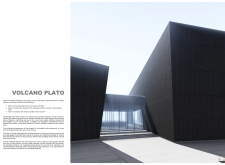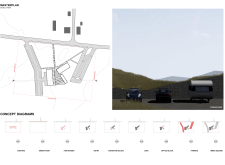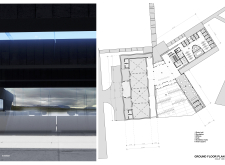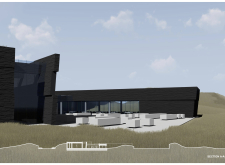5 key facts about this project
Spatially, the project is organized into distinct areas, including exhibition halls, communal spaces, and administrative offices, all carefully arranged to facilitate visitor flow and interaction. The entrance features a large atrium that connects various functions within the building, creating an open and inviting atmosphere. This central space is designed to maximize natural light while offering views of the surrounding terrain, blurring the lines between indoor and outdoor environments.
Considerable attention has been given to the choice of materials, which include reinforced concrete, glass panels, blackened timber cladding, and local stone. Reinforced concrete serves as the primary structural element, providing durability and a contemporary aesthetic. In contrast, the glass panels enhance transparency, allowing visitors to engage with the landscape while navigating through the building. The use of blackened timber echoes the characteristics of volcanic rock, establishing a visual and tactile connection to the site's geological context.
A unique aspect of the Volcano Plato project lies in its minimalistic design approach, which prioritizes environmental preservation. The building’s configuration avoids disruption of the natural scenery, and the parking facilities are strategically positioned to minimize their impact on the volcanic landscape. This consideration reflects an architectural philosophy that values ecological responsibility and community accessibility, catering to both educational and recreational functions.
The exhibition spaces are designed with flexibility in mind, enabling diverse display possibilities that can accommodate various events and educational programs. Interior layouts focus on creating a comfortable visitor experience while integrating advanced climate control systems, ensuring the preservation of artifacts showcased within the museum. By utilizing natural light and effective spatial organization, the design fosters exploration without relying heavily on artificial lighting.
Overall, Volcano Plato exemplifies contemporary architectural practices emphasizing sustainability, context, and form. The integration of natural elements and the thoughtful arrangement of space provide a cohesive visitor experience deeply rooted in its surroundings. For those interested in a deeper understanding of the project, it is recommended to explore architectural plans, architectural sections, and architectural ideas that elaborate on the design's functionalities and technical considerations. The presentation of Volcano Plato offers valuable insights into its architectural narrative and environmental engagement.


























